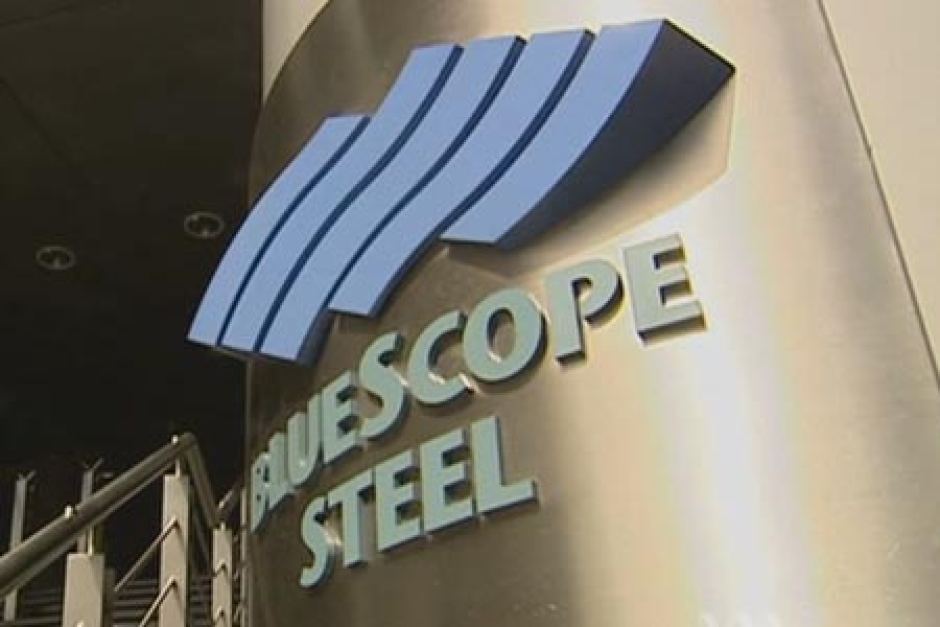Category: Steel / Company News
BlueScope Steel sees 'dramatic increase' in profitability
Friday, 27 May 2016 13:47:46 | Stephen Letts

BlueScope Steel looks set to have free cash flow of $250 million. (ABC TV)
This time last year Australia's biggest steelmaker BlueScope was in serious trouble.
The future of its last blast furnace was under review, it was still haemorrhaging cash and there was no end in sight to the mountains of cheap Chinese steel crushing global markets.
Roll forward 12 months and BlueScope has just announced its second earnings upgrade this year, putting it on track for a full-year profit of around $250 million - an extraordinary rebound from the cumulative $2.2 billion worth of losses racked up between 2011 and 2014.
However, stop work action this week at the Port Kembla steelworks suggest the turnaround is still a challenging work in progress and not without significant pain.
The story of the company's woes are well known; hit by a perfect storm of a soaring input costs, a truculently high dollar and tumbling prices for the goods it made.
Job cuts coincided with the market bottoming
Around the time that region's key pricing metric - the East Asian Hot Rolled Coil - hit its post-GFC low last year, workers at BlueScope's 90-year-old Port Kembla were summoned to a meeting to vote on their future.
The October meeting offered an unpalatable choice; vote for a $200 million cost-cutting plan, including the loss of 500 jobs - or about 15 per cent of the 3,000 strong workforce - put forward by management, or risk the closure of the one remaining blast furnace on which all their jobs depended.
The new wave of redundancies started almost immediately and the workers also accepted a proposal to forfeit pay and working conditions that had been included in a recently ratified enterprise bargaining agreement.
This sort of thing was hardly unprecedented in Port Kembla.
In the early 1980s about half the workforce was retrenched as the economy turned down and trade barriers fell.
Another round of cutting sliced out 1,500 jobs four years ago.
Strike action points to renewed tensions
While this week's $60 million earnings upgrade was supported by higher margins - or spreads as they are known in the steel game - and higher domestic volumes, the bulk of upgrade, around $30 million, was delivered through an earlier-than-expected benefit from the bitter pill the workforce swallowed.
However, there is evidence that tensions are re-emerging with a 24 hour strike at Port Kembla this week.
Australian Manufacturing Workers' Union official Daniel White said the stoppage was a result of anger, frustration and disappointment with events since the October meeting.
"We were damned if we did and damned if we didn't," Mr White said about the vote in support of the job cuts and changes to entitlements.
Mr White said this week's action centred on what was seen as continued pressure on the workforce to produce further savings and the increased use of contract labour, particularly at the Springhill site where the more profitable coated products are made.
"There's no goodwill anymore," Mr White said.
"We were told that the sacrifices the workers made would get us through the next few years, not just the next six months."
BlueScope profits becoming sustainable: analysts
In some ways BlueScope was fortunate to confront its own mortality before its South Australian competitor Arrium and the likes of the British steelmakers, such as Tata, which are still making massive losses and being propped up by the UK Government.
BlueScope headed into the current downturn with low debt and free from an attachment to producing raw products such as iron ore and coal.
It also had a five-year head start on identifying a deep cost cutting program.
From basket-case to market darling, BlueScope's share price has risen 80 per cent over the past 12 months while the broader market has slipped 5 per cent.
While the buoyant steel prices are again rolling over in response to another step up in Chinese production, the same cohort of analysts who questioned the company's future 12 months ago now see the current turnaround as sustainable.
Goldman Sachs analyst Owen Birrell said, while the market weighs up the near-term exposure to falling East Asian steel prices, BlueScope's earnings outlook looks positive into 2017 with another 30 per cent step up possible.
In a recent note to clients, Morgan Stanley's James Rutledge pointed out that far from losing money in the future, his spread sheets point to an excess cash flow of around $250 million pouring out of the company by the end of the 2017 financial year.
"Such as a dramatic increase in gross profitability for now justifies BlueScope management's decision to keep Port Kembla open," Mr Rutledge said.
The AMWU's Daniel White said his members are asking, "What about us? We stretched everything to save the place and we're still getting stretched."
"We get that good profits are important, a solid business means jobs - but there's no sharing in the good times."
However it seems like the drive to push down costs is still far from over.
BlueScope chief executive Paul O'Malley's stated target is to make the company cash positive at the bottom of any cyclical downturn and, according to industry sources, that point still has not been reached.
- About Us
- |
- Terms of Use
- |
-
 RSS
RSS - |
- Privacy Policy
- |
- Contact Us
- |
- Shanghai Call Center: 962288
- |
- Tip-off hotline: 52920043
- 沪ICP证:沪ICP备05050403号-1
- |
- 互联网新闻信息服务许可证:31120180004
- |
- 网络视听许可证:0909346
- |
- 广播电视节目制作许可证:沪字第354号
- |
- 增值电信业务经营许可证:沪B2-20120012
Copyright © 1999- Shanghai Daily. All rights reserved.Preferably viewed with Internet Explorer 8 or newer browsers.




 Send to Kindle
Send to Kindle